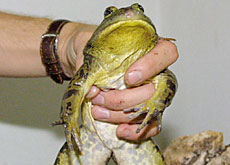Switzerland spared bullfrog scourge – for now

Switzerland is bracing itself for an invasion of bullfrogs which are proving a serious pest in neighbouring Germany.
In the southern German town of Karlsruhe, the giant frogs are munching their way through anything smaller than themselves: other frogs, small snakes, newts and even ducklings.
In the wetland areas outside Karlsruhe – 180 kilometres from the Swiss border – the bullfrogs, which weigh up to two and a half kilogrammes, are threatening the fragile balance of the local ecosystem.
Swiss experts are warning that it could be only a matter of time before the voracious amphibians arrive in the north of the country.
“It is possible they could make it to Basel,” Kurt Grossenbacher, assistant curator of Bern’s Natural History Museum, told swissinfo.
And he warned that the frogs’ huge appetites could push some endangered Swiss species to the brink of extinction.
Headed downstream
As the bullfrog population around Karlsruhe increases, the amphibians are being forced to find new habitats and this could see them heading down the Rhine valley.
If this happens they could end up entering Switzerland. First stop would be the northern town of Basel on the banks of the Rhine.
But Grossenbacher believes that any frogs reaching the north of Switzerland are unlikely to progress much further.
“The Rhine valley has a warm climate and a lot of big forests and those natural conditions stop at Basel,” he says. “I’d say they wouldn’t get far into Switzerland.”
He explained that the landscape and temperatures elsewhere in Switzerland would not sustain the bullfrogs.
Alien species
North American bullfrogs were imported to Europe more than 50 years ago, with most of them ending up on dinner plates in France and Italy.
Their thighs, which are meaty and perfect for lightly frying in garlic butter, were sought after by discerning diners. But now the tide has turned and the frogs are biting back.
In Germany, where frogs’ legs don’t rate as a “plat du jour”, the bullfrogs ended up as pets in aquariums and garden ponds. It seems they saw their chance, took it and made a dash for freedom.
Now more than a hundred adult frogs are living and breeding in five sites outside Karlsruhe.
“Even though the current number of frogs is not a problem in itself, we’re concerned because bullfrogs can reproduce in such large numbers,” said Doctor Mikhail Waitzmann, a biologist at Karlsruhe environment agency.
“One female adult, for example, can lay up to 20,000 eggs per year. At the moment we don’t know how many of these eggs will develop into adult frogs but the potential is frightening.”
Authorities in Karlsruhe are trying to round up the bullfrogs to stop them spreading into other areas, whilst at the same time studying the creatures to better understand them.
swissinfo, Sally Mules
The bullfrogs were brought to Europe from the United States 50 years ago
They can weigh up to two and a half kilogrammes and measure 45 centimetres from head to toe.
They eat anything smaller than themselves.

In compliance with the JTI standards
More: SWI swissinfo.ch certified by the Journalism Trust Initiative
You can find an overview of ongoing debates with our journalists here. Please join us!
If you want to start a conversation about a topic raised in this article or want to report factual errors, email us at english@swissinfo.ch.